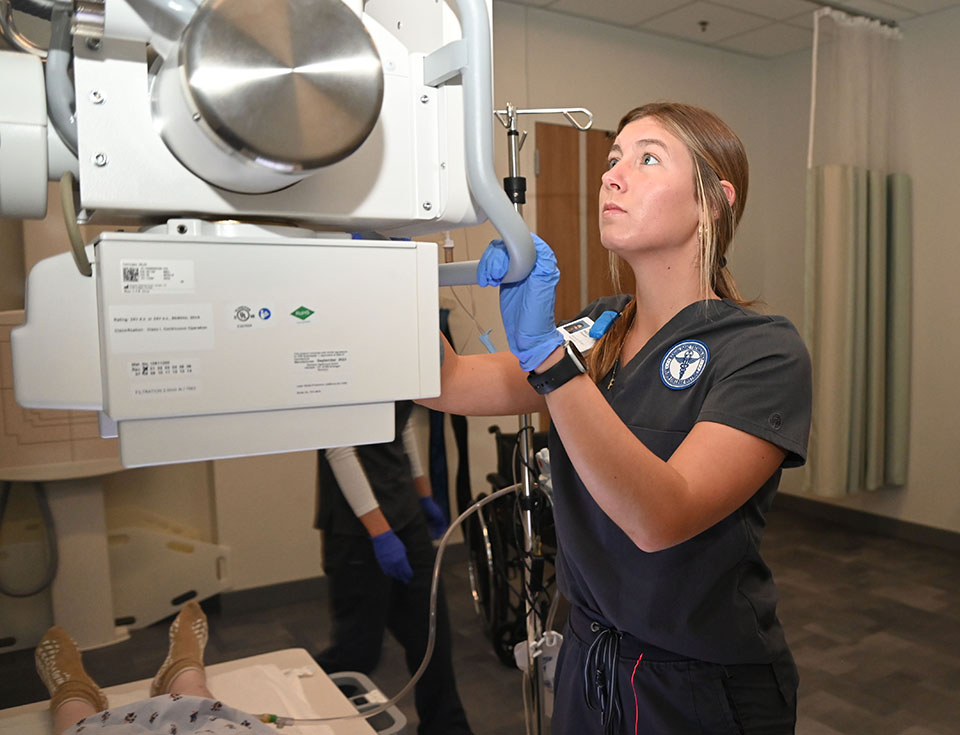How Blinn College helped Presley Rhoades merge healthcare and technology into an exciting career path
Blinn radiologic technology graduates earn more than $75,000 per year and often land jobs before graduation

March 27, 2025
After graduating high school, Presley Rhoades was unsure of her next step. When she started working at a local radiology center, however, the job opened her eyes to the radiologic technology field – and Blinn College became the perfect place to jumpstart her career.
“I always wanted to go into healthcare, but once I started working at the radiology center, I felt this tug at my heart that this is where I should be,” Rhoades said. “One of the things I love about rad tech is that you get to learn everything about the human body. I know about the bones, organs, and you get a lot of experience with patient care. In the end, it’s all about helping people get better, and that means a lot to me.”
Radiologic technologists use specialized medical equipment to create images of patients’ bodies to help doctors diagnose and treat diseases and injuries. Blinn’s two-year Radiologic Technology Program is based at Texas A&M-RELLIS in Bryan, where students gain hands-on skills utilizing the campus’s 16,000-square-foot simulation laboratories. In addition to classroom and lab work, students also put their training into practice through clinical rotations at area hospitals and outpatient clinics.
Rhoades connected with fluoroscopy (fluoro) during her clinicals and hopes to dive deeper into this specialty that uses X-rays to produce live, continuous images of internal structures.
“Fluoro is really interesting because you get to work with the doctors and sometimes speech pathologists,” Rhoades said. “It’s not just one picture, it’s an ongoing picture, and you get to see a lot of different things besides bones.”
Blinn’s nationally accredited program provides students with extensive training in patient care and safety, anatomy and physiology, image production, equipment operation, radiation protection, and radiographic procedures.
Rhoades thinks radiologic technology is a great option for students looking to combine technology and healthcare.
“I have learned so much about computers that I never knew before,” she said. “You get to learn about circuits, how the computer works, and the biology at work behind it. I really get to use technology to help people.”
In addition to the advanced equipment students train with, Rhoades credits Blinn’s dedicated faculty with making all the difference.
“The faculty at Blinn is very supportive. They want you to succeed,” she said. “They know their stuff and make sure we do as well.”
Blinn Radiologic Technology Program graduates have a 96% first-attempt pass rate on the American Registry of Radiologic Technologists (ARRT) certification examination and a 100% job placement rate over the past five years.
Rhoades’ plans after her May 2025 graduation reflect this success. She has accepted a position at Baylor Scott & White Medical Center in College Station and hopes to cross-train to perform computed tomography (CT) scans.
“There are just so many things you can branch off into with this degree. You can go into MRI, CT, IR, which is interventional radiography,” Rhoades said. “We can start IVs, which people don’t often know about. It’s a really dynamic field with the opportunity to train for additional specialties while you’re working.”
According to the U.S. Bureau of Labor Statistics, radiologic technologists earn a median salary of $76,020 per year and employment is projected to grow 6% between 2023 and 2033.
For more information, visit www.blinn.edu/radiologic-technology.
Enjoy this article? Share it with one click!